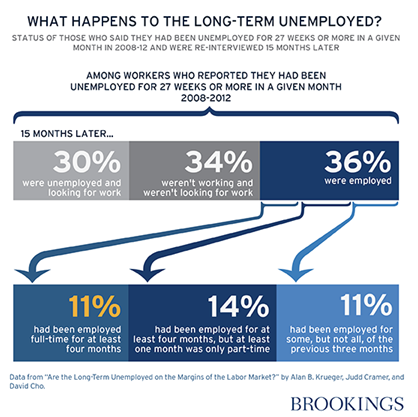In the years following the financial crisis, economists have been puzzled by a curious fact about the labor market in the U.S. With unemployment high – meaning there was an excess supply of labor – traditional models suggested that both wages and inflation should fall.
Neither has been the case in the U.S. in recent years, and a new report by a trio of economists from Princeton University suggests a reason: The long-term unemployed have been so marginalized that their presence in the market no longer has a discernible effect on wages and inflation. In fact, when the economists eliminated the long-term unemployed from their equations, the predictions snapped right back to what the models would have predicted.
Related: Unemployment Insurance Plan Shot Down by Boehner
Economists warn that this is no small concern. In a press conference yesterday, Federal Reserve Board Chairman Janet Yellen said that the rate of long-term unemployment remains “immensely high.”
“The U.S. labor market is fundamentally different than it has ever been before in our history. For the first time ever, we have a huge problem with long-term unemployment,” said economist Justin Wolfers, a senior fellow in economic studies at Brookings.
The authors of the paper, former White House Council of Economic Advisers chair Alan B. Kreuger, Judd Cramer, and David Cho, also studied outcomes for the long-term jobless, and the results were not encouraging. Using data from 2008 through 2012, they determined that given a sample of unemployed workers, only 11 percent could expect to have found good, long-term employment within the next fifteen months. (See chart.) Another 25 percent could expect to find short-term or part-time work during that time period. But after 15 months, 64 percent could expect to remain jobless.
“The decline in job vacancies during the Great Recession set in motion a dynamic that led to unprecedented long-term unemployment and a rise in the unemployment rate,” the authors write. They find that the characteristics of the long-term jobless point to a diverse population that is spread across the country, and not limited to specific groups or regions.
Related: Retroactive Unemployment Checks Are Cold Comfort to Some
Their research found that the personal characteristics of an individual, such as education, industry sector, and occupation, have little predictive value when measuring the likelihood of someone’s being jobless.
“The portrait of the long-term unemployed in the U.S. that emerges here suggests that, to a considerable extent, they are an unlucky subset of the unemployed,” the authors find.
Reintegrating them into the working world, they said, will pose multiple challenges.
“Overcoming the obstacles that prevent many of the long-term unemployed from finding gainful employment, even in good times, will likely require a concerted effort by policy makers, social organizations, communities and families, in addition to appropriate monetary policy,” they write.

Top Reads from The Fiscal Times
- Is the Middle Class Better Off Than We Think?
- Did the Obama White House Protect GM?
- Where Unemployment Insurance Benefits Stand in Your State




